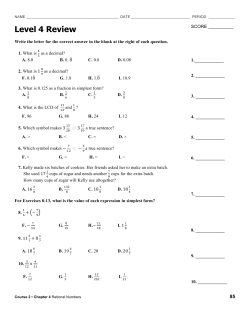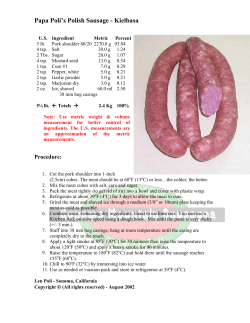
NP, Matchings, and the TSP. A perfect k-matching
1 NP, Matchings, and the TSP. A perfect k-matching (i.e., a k-factor) M in a graph G is a subset of its edges such that k edges of M meet each node of G. A Hamilton cycle (i.e,. tour) in G is a 2-factor which forms a connected subgraph of G. The traveling salesman problem (TSP) in “decision problem form” is, given a graph G with a cost for each edge and given a tour H in G, is there a tour in G which is cheaper than H? A decision problem Q is said to be in P when there a polytime algorithm which correctly answers, yes or no, for any input to Q; and Q is said to be in NP when for any input where the answer is yes there is a polynomial time way to demonstrate that the answer is yes; coNP of course means ‘not Q’ is NP. Clearly the TSP is NP. In 1967 after trying unsuccessfully to find the TSP to be in P, Edmonds conjectured that it is not, which immediately implies NP ≠ P. In the process of trying to ‘well-solve’ TSP, he did well-solve the optimum k-factor problem. That is, in particular, he did find a rather complicated polynomial time algorithm which answers yes or no to the question, given G and a 2-factor M in G, is there a 2-factor in G which is cheaper than M. A big hurdle in this was finding what he dubbed a “good characterization” of optimum 2-factors in G which puts the question unobviously in coNP, as well as obviously in NP. The approach is the following: let J be the set of incidence vectors of 2-factors in G. Clearly membership in J has an NP description. Edmonds’ theory provides an NP description of a very large set L of linear inequalities such that the solution set of L is the convex hull of J, and so applying the linear programming duality theorem to L provides a polynomial time way to certify that a given member of J is optimum. He hoped unsuccessfully, and it is occasionally still hoped, to find an NP description of a system L’ of linear inequalities whose solution set is the convex hull of the (NP-describable) set of incidence vectors of tours in G. If there is no such set L’ then NP ≠ coNP, and so NP ≠ P. Jack will explain this to you in the second day of his Queen Mary gig. Then, in the first day of his LLTC gig, he will explain some related successes with polyhedra given by submodular set functions. 2 More than fifty years ago, Jack was perhaps the first person to make a clear distinction of “easy” (polynomial time) and “hard” problems, and “easily certifiable” answers, now formalised as P and NP. The concepts of P, NP, and co-NP together with discussion and conjectures are clear in Jack’s papers from the mid-1960s, including the conjecture that there is no polynomial time algorithm for the traveling salesman problem (TSP). In the early 1970s, Stephen Cook, Leonid Levin, and Richard Karp, showed that various familiar NP problems, including the TSP, are as hard as any NP problem, that is, NP Complete. Since then, using the assumption of the non-easiness of TSP, that is, NP ≠ P, and trying to prove or disprove it, have become a staple of the fields of combinatorial optimization and computational complexity. Jack is known for many other important results such as the “blossom algorithm” for maximum matching, the matroid intersection theorem, theory of polymatroids and submodularity ( f(AUB) + f(A∩B) ≤ f(A) + f(B) ) , and much more. He is still creative, with recent work on Euler complexes and Nash equilibria among other things, and he loves to perform.
© Copyright 2025










